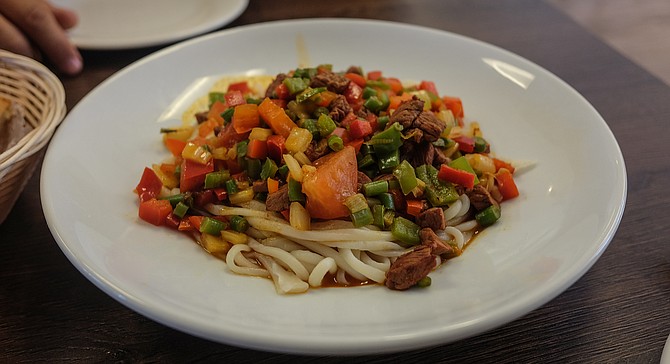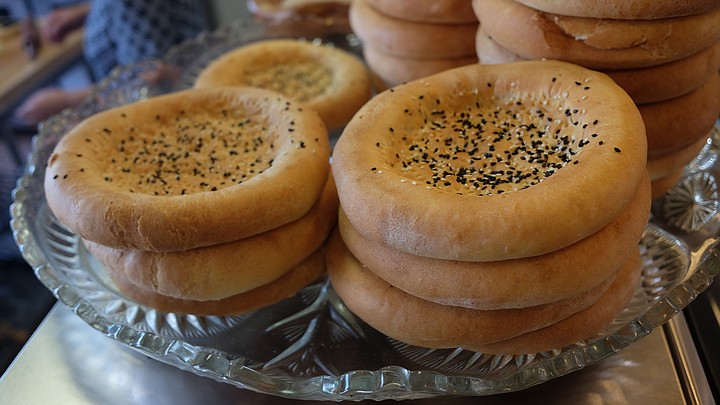 Facebook
Facebook
 X
X
 Instagram
Instagram
 TikTok
TikTok
 Youtube
Youtube

It’s an old joke by now, something along the lines of: "going to war is how Americans learn geography." I’ve laughed about it myself, but I’ve been able pick out Kuwait and Vietnam on a map for most of my life. The same could not be said about Xinjiang.
Not until Kroran Uyghur Cuisine opened this spring in Clairemont. What is Uyghur cuisine? forced me to wonder, how do you pronounce Uyghur, anyway?

As I eventually learned, it’s pronounced ˈwē-ˌgu̇r, and refers to a culture native to Xinjiang, the autonomous region in the westernmost part of China, roughly between Mongolia and Tibet. Sure, I can’t be expected to know about every little corner of China. But Xinjiang is huge, about the size of Alaska. That’s four times the size of California, folks!

Historically (I have learned), its capital city, Ürümqi, was a major hub along the Silk Road, connecting trade between China and the Middle East. Culturally and ethnically, the region seems to have more to do with the latter; located 1500 miles west of Beijing, the official language of Xinjiang is not Mandarin, but Uyghur, a Turkic language, and the majority of its 20 million residents practice Islam.

Xinjiang sits in the dead center of Asia, and its cuisine draws influences from every direction. The Kroran menu reflects this, featuring dishes associated with multiple cultures.
For example, laghman. Said to be a signature meal in Xinjiang, it features hand-pulled noodles, which are typically found in Chinese cuisine, and lamb, which is not. Another lamb dish, called plov, sees rice steamed over a mixture of meat and vegetables cooking in what the Kroran menu describes as a “cast iron wok-shaped cauldron.” Turns out, plov runs in the same tradition as the Indian rice pilaf, to the point it’s pronounced almost the same way. While Kroran’s flat bread, nan, shares an obvious connection to Indian cooking, this version is less flat and crustier, topped with sesame seeds.
Along with lamb dishes, I’ve read that Uyghur cuisine is far more likely than Chinese to use aromatic south Asian spices such as cumin, so I was a bit surprised to find Kroran using very little spice in these dishes, choosing instead to let the ingredients dictate the flavors. The thin sauce dressing the exceptionally chewy laghman noodles really amounted to the runoff from bell peppers, tomatoes, green beans, and a light cooking oil. I expected the plov to taste like lamb, but carrots and onions did most of the work, plus a hint of currants.
Kroran sits in a small strip mall, not far from the Clairemont DMV, and though it plays everything pretty low key, its owner comes from Xinjiang, and décor refers to his home culture, including tapestries, craft objects, and musical instruments such as the two-string dutar.
Since I’d never heard of it prior to last week, I have no idea how well his food performs as an example of Uyghur cuisine, just that there are plenty of noodle dishes, meat skewers, and stews to be tried. I enjoyed it enough to try again, and I am definitely grateful he opened up this part of the world to my palate. I’d much rather learn my geography served on a plate than appearing on the nightly news.


It’s an old joke by now, something along the lines of: "going to war is how Americans learn geography." I’ve laughed about it myself, but I’ve been able pick out Kuwait and Vietnam on a map for most of my life. The same could not be said about Xinjiang.
Not until Kroran Uyghur Cuisine opened this spring in Clairemont. What is Uyghur cuisine? forced me to wonder, how do you pronounce Uyghur, anyway?

As I eventually learned, it’s pronounced ˈwē-ˌgu̇r, and refers to a culture native to Xinjiang, the autonomous region in the westernmost part of China, roughly between Mongolia and Tibet. Sure, I can’t be expected to know about every little corner of China. But Xinjiang is huge, about the size of Alaska. That’s four times the size of California, folks!

Historically (I have learned), its capital city, Ürümqi, was a major hub along the Silk Road, connecting trade between China and the Middle East. Culturally and ethnically, the region seems to have more to do with the latter; located 1500 miles west of Beijing, the official language of Xinjiang is not Mandarin, but Uyghur, a Turkic language, and the majority of its 20 million residents practice Islam.

Xinjiang sits in the dead center of Asia, and its cuisine draws influences from every direction. The Kroran menu reflects this, featuring dishes associated with multiple cultures.
For example, laghman. Said to be a signature meal in Xinjiang, it features hand-pulled noodles, which are typically found in Chinese cuisine, and lamb, which is not. Another lamb dish, called plov, sees rice steamed over a mixture of meat and vegetables cooking in what the Kroran menu describes as a “cast iron wok-shaped cauldron.” Turns out, plov runs in the same tradition as the Indian rice pilaf, to the point it’s pronounced almost the same way. While Kroran’s flat bread, nan, shares an obvious connection to Indian cooking, this version is less flat and crustier, topped with sesame seeds.
Along with lamb dishes, I’ve read that Uyghur cuisine is far more likely than Chinese to use aromatic south Asian spices such as cumin, so I was a bit surprised to find Kroran using very little spice in these dishes, choosing instead to let the ingredients dictate the flavors. The thin sauce dressing the exceptionally chewy laghman noodles really amounted to the runoff from bell peppers, tomatoes, green beans, and a light cooking oil. I expected the plov to taste like lamb, but carrots and onions did most of the work, plus a hint of currants.
Kroran sits in a small strip mall, not far from the Clairemont DMV, and though it plays everything pretty low key, its owner comes from Xinjiang, and décor refers to his home culture, including tapestries, craft objects, and musical instruments such as the two-string dutar.
Since I’d never heard of it prior to last week, I have no idea how well his food performs as an example of Uyghur cuisine, just that there are plenty of noodle dishes, meat skewers, and stews to be tried. I enjoyed it enough to try again, and I am definitely grateful he opened up this part of the world to my palate. I’d much rather learn my geography served on a plate than appearing on the nightly news.
Comments